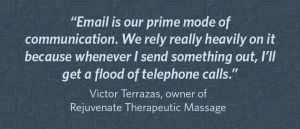My buddy Markus Frind famously claimed that he worked 10 hours per week building his website.
All by himself, he was the CEO, CMO, lone support rep, server admin, PR agent, and everything else.
Two years ago, he sold it for $ 575 million in cash.
Not everyone will have that combination of genius and luck. But if you’re an entrepreneur, consultant, or agency owner, listen up.
If your revenue model is billable hours, then you have an incentive to increase occupancy (billed time divided by total time).
Industry standard is 70%, which means you or your people must bill 6 hours in each 8.5 hour day.
Keep in mind what Paul Sokol says:
“Time isn’t money. Valuable time is money. You have to know which are your most revenue producing activities and focus on those so you can price accordingly”
But if you’re in an area like marketing technology or a field where there is steep learning curve, you need to maximize your effectiveness first.
I have been doing this twenty years and still spend 3 hours a day learning, if not more, as Molly Pittman of DigitalMarketer.com suggests:
I believe you should pursue growth and learning everyday. Blocking out time on your calendar for education is essential, no matter the number of hours you “work”.
believe you should pursue growth and learning everyday. Blocking out time on your calendar for education is essential, no matter the number of hours you “work”.
That’s time you can’t bill– at least if you’re ethical.
And that’s not counting non-client time for general chit-chat (what did you do last weekend), organizing your desk, and surfing the web.
Assume you have one hour for such pleasantries each day.
That means you can’t work more than 4 hours per day, unless you extend your workday beyond what is sustainable long-term.
This also means that if you can bill only half as many hours, you have to charge at least twice as much per hour.
If you bill at $ 50/hour, then you need to start charging at least $ 100/hour, for example.
But I’ll have fewer clients, you say– I’m afraid my business will dry up!
Actually, you’ll find you get better clients who pay you more, respect your expertise, and treat you better. There are clients that value results and clients that just want the cheapest wage slaves. You figure out which of these two are the better clients to have.
If you want to buy an hour of consulting with me, it’s $ 750.
We actually get more clients at $ 750 than at $ 150, which we’ve tested over the years. And the $ 750 ensures we have serious inquiries– plus gives us room to over-deliver. We usually put in two hours and also share the internal documents that will help them implement a particular fix.
But how much should YOU be charging? We discuss that in more detail here.
If you’re just starting out, sure, you need to charge a low rate to get your initial base of clients. And then you can raise your rate, while also transitioning to packages.
When you sell a package of services (driven by your checklist), should the client care if it takes you 2 hours or 20 hours to get results? If they’re paying you by the hour, you have an incentive to drag your feet– take twice as long and earn twice as much.
And if you’re not operating according to a checklist of items as part of a package, you have no control over your quality nor can the client effectively manage you. With a checklist, everyone is clear at the start what you will do and not do. No need to negotiate a SOW, suffer from scope creep, or agonize over missed expectations.
Are you selling your time or your expertise?
If you’re still selling time, start to package up what you do and attach a cost to it.
The more you can reliably repeat something, the faster you get, the more competent you become, and the more you can delegate to others to do it.
Follow the content > checklist strategy to scale up your business and squish execution problems at the same time.
And what would have taken you 6 hours, you can do in an hour, plus no need to keep explaining what you do (which is likely 30% of your time).
This is not about “4 hour workweek” or automating/delegating your life to assistants and software.
Rather, I’m saying you need to actively invest in yourself– to treat your learning time with the same respect as a big client meeting.
Now do you agree with me that you should “work” no more than 4 hours per day?
Business & Finance Articles on Business 2 Community
(105)
Report Post




